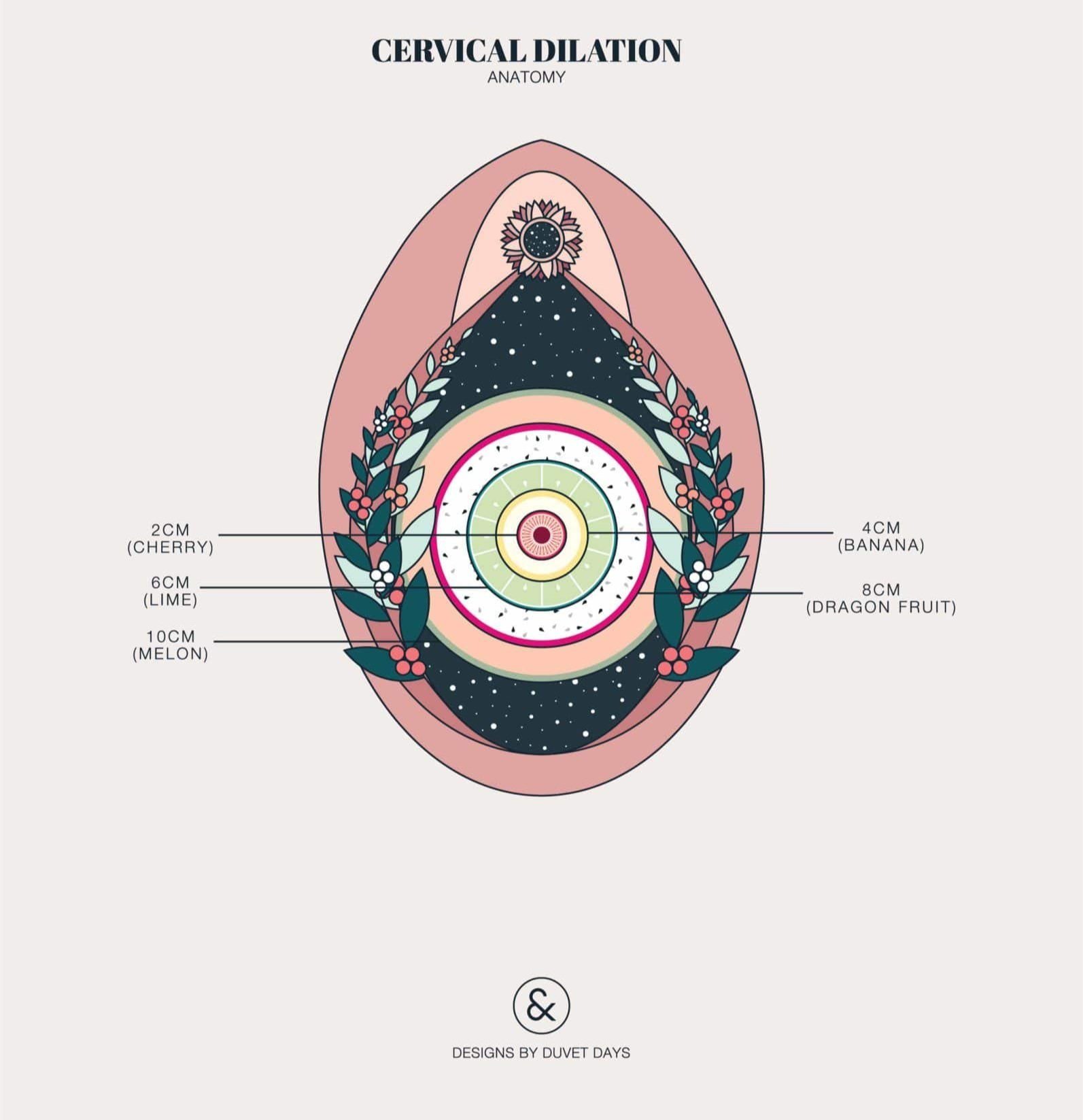C is for Cervical Recoil
Did you know that the cervix can ‘recoil’ or ‘un dilate’ (ie close in) during labour as well as dilate (open)? Well it can, although it’s definitely not something that we want to happen. Because your cervix needs to dilate to give baby an exit pathway out into the world. But recoiling can happen, and it can be really disheartening (to say the least). It can also cause your healthcare team to want to intervene / interfere. But actually the opposite of this would be FAR MORE helpful. That’s exactly why I’m writing this piece, so that you can be informed should this happen to your cervix, can understand the ‘why’ and what choices you have and may make.
So why might your cervix close back in or recoil?
So the first stage of labour is the cervix softening and thinning (effacement), then opening (dilating). Only once the cervix is fully dilated (around 10cms) can your uterus then start to move the baby down and out to be born (the second stage of labour).
Well cervical recoil is a sign that your brain is not feeling safe. That you brain has decided that perhaps this time and place you’re in are not a safe place to birth a baby right now. So instead your brain decides that (for the time being) it’s better to keep this baby safe inside the womb instead. To keep baby safe this can manifests in either
1) labour slowing down - ie the cervix pausing and not opening any further. If you’ve heard the awful phrase ‘failure to progress’ this is what is happening.
or
2) a more extreme version is that the cervix closes back in or recoils.
Either situation is not what we want. But also neither of these mean that your body or baby are failing in anyway. It’s a response mechanism to keep you and your baby safe. And just as it’s caused a ‘pause’ in labour, it can be restarted again. That’s important. Read on…
What is cervical recoil, and why is it important to know about?
It’s important to know that not all cervixes behave in the same way. They really don’t. There is no such thing as a ‘text book’ cervix! Just like there isn’t a text book pregnancy, labour or birth (or indeed way to be a mother). There should not be a set rules of how your cervix dilates in labour (yet often it feels that there can be at certain hospitals or trusts). About this, Dr Sara Wickham (well respected maternity researcher) says “my current conclusion is that existing textbook knowledge leaves out or ignores some important key knowledge and principles.”
The idea that cervical dilation can decrease as well as increase in labour is not in the textbooks - yet it happens. A cervix which was six cms dilated can later in labour be two or three cms (the exact numbers aren’t that important). A situation where the cervix is closing rather than opening can and does happen. So it’s important to know that this does not mean your cervix has a fault.
What can cause cervical recoil?
Cervical recoil tends to be the result of an interruption or a disruption to labour.
For example it could be that there is a PERSON in the birth space that the woman or birthing person does not feel completely safe with. Perhaps a stranger, like a member of the care / medical team who does not seem supportive or on the same wavelength, or it could be a family member who disrupts the energy. This may be completely unintentional - but it still has an effect on the brain feeling safe and the delicate hormonal cocktail that birth requires.
Or it could be the PLACE that she’s in. Maybe in transitioning from home to a birth centre or hospital in the car, or maybe from triage to labour room or from one labour room to anothers. This change in the environment can lead to not feeling so safe. and so the brain puts the brakes on and causes a temporarily stop in the physiological labour process.
It could also be a birth INTERVENTION or a CHECK, like being asked lots of questions, having to move positions to listen to babys heartrate (or have a continuous monitor attached) or like a vaginal examination being carried out that disrupts the delicate balance. And at which point it can become apparent that the cervix has either paused in dilating, or that it is less dilated (has recoiled) than it was at a previous check.
Infact it could be anything at all that gets her out of the zone, and interupts the process of birth.
so Why do cervixes recoil?
It’s a basic instinct and response to perceived ‘threat’ and feeling unsafe in some way (big or small) that all mammals have - humans included (and don’t forget we have the same birth physiology and responses as other mammals do). All mammals need to feel safe from the threat of predators in order to relax their minds and bodies enough to give birth. Through the first stage of labour the cervix thins and then opens, and one way midwives can measure the progress of this stage and how labour is progressing is to chart cervical dilation (please remember this is always a choice - you can say no to any vaginal examination including those to measure the progress of the cervical dilation). So if she feel unsafe in any way, then her cervix may close up a bit - or sometimes a lot.
It’s actually a healthy and protective mechanism if you think about. How clever of your body to be able to stop the process of labour if it wasn’t a safe time and place to birth (certainly thousands of years ago when you didn’t want you or your baby being eaten by a sabre toothed tiger!). So it’s normal and not a problem. Once you feel safe again, then the process will restart. Very clever indeed. Why would nature have us give birth in a situation in which we felt unsafe? So cervical recoil is a clever safety mechanism. The cervix closes up a bit / a lot to keep the baby safely inside until it’s safe again.
So how can be get the cervix to restart dilation?
Well this is the important bit. We need less (NOT more) interferring, poking, proding, measuring, watching and chatting to about it. Instead your body needs time and space to feel safe again, to have the time to follow it’s own birthing instincts and in it’s own time. Patience is key. Given this (and assuming all else is well with mum and baby) then the labour will almost always start up again on its own, and the opening of the cervix will start to increase again. I’ve heard midwives say it can take just minutes for the woman to get back to the same point in labour!
But you need to change whats going on. This could be by:
~ Asking for privacy, to aid the feeling of safety and not being watched.
~ Body autonomy and free movement - tune into your body and feel uninhibited to move freely and intuitively
~ Remove the people who aren’t helping from the birth space. ie get the birth partner to ask them to leave. Or ask them yourself of course. Might feel a little awkward, but it is important - so do it! Explain the why if you need to. It’s not personal as such, it’s just not right at this delicate moment
,~ Change the setting ie the environment so the labouring womans brain feels that it is safe to bring the baby earth-side. That can be harder in a hospital than at home, but still possible. Make the place look less clinical and more homely. Lower the lighting, put on some battery candles, turn on some music or a hypnobirthing track, plug in a room diffuser to help the room smell familiar and relaxing or use a room spray, get in the bath or pool, practice one of the breathing techniques form my hypnobirthing course, get your partner to give you a massage (loving touch works wonders).
There’s lots more idea that I’ll share with you on my Complete Antental & Hypnobirthing Courses. The solutions you need are there. I can show you so, so, many and they really work.
And don’t let anyone dismiss them, they are powerfully effective however subtle they may seem. Birth physiology and hormones are subtle (and easily disrupted) - that’s the point!
The reality of modern maternity system
Be prepared to stand firm. It can be tricky in todays maternity system with perhaps a doctor hoving around wanting to ‘do’ something and where patience and time are sadly more lacking than ever (NHS cuts). But also get your midwife on your side to advocate for you - that’s exactly what they are there for. To support you and your birth. They are there to work as a team with you.
Don’t let the old fashioned words ‘failure to progress’ get you down (what an awful phrase). If artificial oxytocin is mentioned (syntocinon / pitocin) to get things going / speed things up, then ask yourself what you feel about this? Use the BRAINS acronym. Ask about trying the CHANGE things so your mind feels safe first, before going down the artifical intervention route. Get birth physiology back on track.
If you’re brain really does feel unsafe, it’s actually quite likely that it may take a lot of syntocinon to override this safely mechanism of cervical recoil. So keep remembering that the lack of progress may well be the result of the drugs and interventions given to correct a physiologically normal and evolutionarily helpful behaviour.
In a nutshell
So in a nutshell the term ‘cervical recoil’ reflects the fact that the cervix is generally closing because the woman’s body is recoiling from something that is disturbing her sense of safety. It is simply a woman’s body reacting in a normal, protective and physiologically helpful way. It’s not something that someone needs to ‘rescue’ you from. Prioritise patience, privacy, relaxation, understanding and feelings of safety - and let your body responded to that.
For more information
While midwives have long understood that the dilation of the cervix is not unidirectional, it hasn’t been written about extensively. It was noted and described in a research study by Betty-Anne Daviss (who coined the term cervical recoil) and Ken Johnson (1998), further described by Ina May Gaskin, who discovered that it was called pasmo in parts of South America, and a few other midwives, including Dr Sara wickham, have written up our own thoughts.
And if you want more of this knowledge and information, to learn so many techniques and tips that can empower you and your birth partner to have the best possible birth for you, then do find out more on my no BS complete Hypnobirthing & Antenatal Courses
It really can make so much difference to having an empowered birth experience
Susan x


